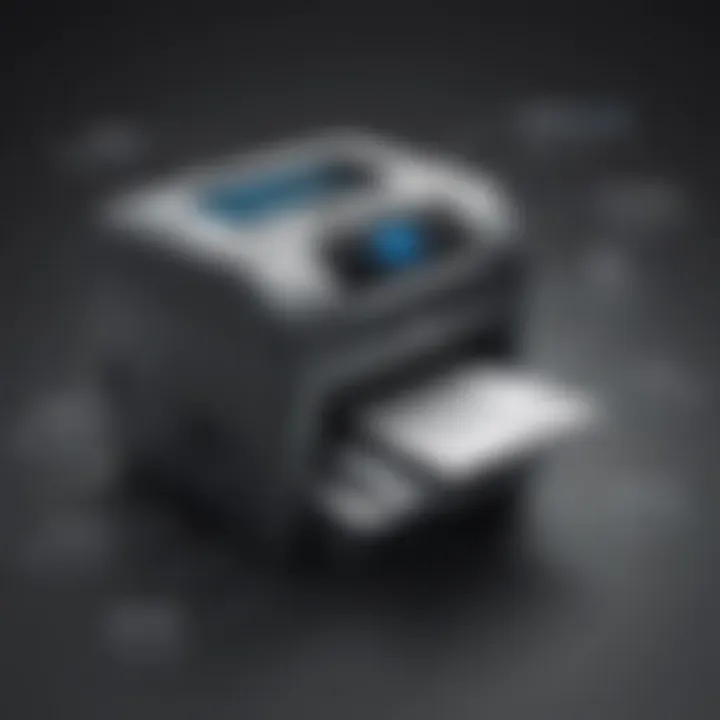Effective Solutions for HP Printer Complaints: A Comprehensive Guide


Overview of common issues with HP printers
HP printers have become an indispensable tool in offices and homes worldwide, offering reliable printing solutions. However, users often encounter a myriad of complaints ranging from connectivity issues to print quality problems. Understanding these common concerns and learning how to address them effectively is crucial for optimizing printing performance.
Troubleshooting Connectivity Problems
One of the major complaints associated with HP printers is connectivity issues. Users may face challenges connecting their devices to the printer either wirelessly or through a USB connection. Understanding the root causes of these problems and implementing targeted solutions can help users overcome connectivity glitches and ensure seamless printing.
Enhancing Print Quality
Another prevalent complaint revolves around print quality discrepancies. Users may notice problems such as streaks, smudges, or faded prints, diminishing the overall output quality. By delving into the factors affecting print quality and implementing adjustments in settings and maintenance practices, users can enhance the clarity and professionalism of their prints.
Maintaining Printer Performance
In addition to addressing specific complaints, preserving overall printer performance is essential for prolonged functionality. Regular maintenance practices such as cleaning the printer heads, aligning cartridges, and updating firmware can prevent common complaints and ensure consistent printing quality.
Conclusion
Introduction
In the realm of modern office machinery, HP printers stand out as ubiquitous tools for producing documents and materials. However, even the most reliable machines can encounter issues that impede their functionality. This comprehensive guide aims to delve into the common complaints that users may face with HP printers and provide effective solutions to tackle these challenges head-on, ensuring a seamless printing experience.
As technology continues to evolve at a rapid pace, the reliance on efficient printing solutions has become paramount for businesses and individuals alike. Understanding the intricacies of HP printers and being equipped with the knowledge to troubleshoot common issues is essential in maximizing productivity and minimizing disruptions in the workflow. This guide is designed to empower users with the skills and insights necessary to address a myriad of printer-related concerns, from connectivity problems to print quality discrepancies.
Through a systematic exploration of the various types of complaints that users may encounter, this guide strives to offer practical and actionable recommendations that cater to a diverse range of scenarios. By delving into the nuances of connectivity issues, print quality problems, paper handling challenges, ink cartridge issues, and software-related concerns, readers will gain a comprehensive understanding of the potential hurdles they may face with their HP printers.
Furthermore, by providing step-by-step troubleshooting methods and innovative solutions to common complaints, this guide aims to equip readers with the tools needed to overcome printing obstacles effectively. With a meticulous focus on detail and a dedication to optimizing the functionality of HP printers, this guide sets out to be a valuable resource for those seeking to enhance their printing experience and navigate the intricacies of printer maintenance with confidence and proficiency.
Common HP Printer Complaints
In the realm of HP printers, encountering various complaints is not uncommon. Understanding these common issues is vital for users to tackle them effectively and ensure smooth printing operations. Diving into the intricacies of connectivity problems, print quality issues, paper jams, ink cartridge malfunctions, and software glitches equips users with the necessary knowledge to troubleshoot their HP printers optimally.
Connectivity Issues


Wireless Connection Problems
Wireless connectivity problems represent a significant challenge in the realm of HP printer complaints. Users often grapple with issues such as dropped connections, slow transmission speeds, or failure to establish a connection at all. Addressing these wireless concerns is paramount for seamless printing experiences. The convenience of wireless printing is undermined when these connectivity problems persist, making it essential to delve deep into troubleshooting techniques specific to wireless connections.
Wired Connection Troubleshooting
While wired connections are known for their reliability, they can also pose their own set of challenges. Users may encounter issues with cable connections, ports, or interference affecting the wired connection stability. Understanding how to troubleshoot these wired connection problems ensures a robust printing setup that leverages the benefits of wired connectivity for consistent and reliable print jobs.
Print Quality Problems
Blurry Prints
Achieving crisp and clear prints is the ultimate goal for any printing task. However, blurred prints can derail this objective, resulting in subpar output. Understanding the root causes of blurry prints, whether related to printer settings, hardware issues, or toner problems, is imperative for rectifying this common complaint. By addressing factors contributing to blurry prints, users can elevate the quality of their printed materials with precision and clarity.
Faded Printing
Faded printing poses a similar challenge by producing output that lacks vibrancy and depth. Whether caused by low toner levels, incorrect print settings, or printer age, faded prints diminish the impact of printed documents. Exploring methods to combat faded printing enhances the overall print quality, ensuring that documents and images appear vivid and professional.
Alignment Errors
Alignment errors in printing can lead to misaligned text or images, affecting the overall presentation of printed materials. Resolving alignment issues requires a keen eye for detail and an understanding of printer calibration techniques. By addressing alignment errors promptly, users can guarantee precise and accurate prints that align perfectly, enhancing the overall aesthetic and readability of documents.
Paper Jams and Feeding Problems
Resolving Paper Jams
Paper jams are a common frustration faced by printer users, disrupting workflow and causing delays. Knowing how to effectively address paper jams, whether through manual removal techniques or adjusting printer settings, is key to maintaining printer functionality. Clearing paper jams swiftly and correctly ensures smooth printing processes without interruptions.
Improving Paper Feed Mechanism
Optimizing the paper feed mechanism is essential for preventing paper jams and ensuring consistent paper handling. Understanding how to adjust paper settings, inspect the paper path, and maintain proper paper alignment enhances the efficiency of the paper feed mechanism. By improving paper feed mechanisms, users can minimize paper-related disruptions and enhance overall printing productivity.
Ink Cartridge Issues
Cartridge Errors


Issues with ink cartridges, such as unrecognized cartridges or cartridge errors, can impede printing tasks significantly. Addressing these cartridge-related concerns involves troubleshooting both hardware and software aspects to restore ink cartridge functionality. By resolving cartridge errors effectively, users can maximize the lifespan of their ink cartridges and maintain uninterrupted printing operations.
Low Ink Warnings
Low ink warnings alert users to dwindling ink levels, prompting timely action to replace cartridges and avoid running out of ink mid-print. Understanding how to interpret and respond to low ink warnings ensures continuous printing without quality disruptions. Proactive management of ink levels based on low ink warnings guarantees optimal print quality and prolonged cartridge durability.
Software and Driver Related Concerns
Updating Printer Drivers
Regularly updating printer drivers is essential for ensuring optimal performance and compatibility with various devices. Outdated drivers can lead to functionality issues and hinder print quality. Understanding how to update printer drivers effectively, whether through manual downloads or automatic updates, is crucial for maintaining peak printer performance. By staying abreast of the latest driver updates, users can address compatibility issues and maximize printing efficiency.
Troubleshooting Software Glitches
Software glitches can manifest in various forms, from print spooler errors to printing delays caused by software conflicts. Resolving these software-related concerns demands a systematic approach to identify and address underlying issues. By troubleshooting software glitches methodically, users can enhance printer functionality and eliminate potential obstacles to smooth printing operations.
Troubleshooting and Solutions
In this article, the segment on Troubleshooting and Solutions holds paramount significance. It serves as the core component in addressing the prevalent complaints related to HP printers comprehensively. By delving into troubleshooting methods and providing effective solutions, this section aims to equip readers with the necessary tools to tackle various issues that may arise with their HP printers. Understanding the nuances of printer troubleshooting not only enhances technical proficiency but also optimizes printer performance and user experience.
Step-by-Step Connectivity Fixes
Resetting Network Settings
Resetting Network Settings plays a pivotal role in restoring the connectivity functionality of HP printers. This technique involves resetting the network configurations to their default state, resolving conflicts or errors that impede smooth communication between the printer and connected devices. One key characteristic of Resetting Network Settings is its ability to troubleshoot common network issues effectively, ensuring seamless printing operations. Despite its simplicity, this procedure can offer substantial benefits in overcoming connectivity challenges, making it a preferred choice for addressing connectivity complaints in this guide.
Checking Router Configuration
Checking Router Configuration is integral to ensuring a stable connection between the HP printer and the network infrastructure. By verifying the settings of the router that affect printer communication, users can identify and rectify any misconfigurations that might hamper smooth printing processes. The key characteristic of this step lies in its ability to troubleshoot connectivity issues originating from router settings, making it a popular choice in this guide for addressing network-related complaints. While this method aids in enhancing connectivity, users must also be aware of its limitations and potential disadvantages to make informed decisions.
Enhancing Print Quality
Cleaning Print Heads


A critical aspect of improving print quality is Cleaning Print Heads. This process involves removing any accumulated ink residue or debris from the print heads, ensuring clear and precise printing output. The key characteristic of Cleaning Print Heads is its effectiveness in resolving common print quality issues like streaks or smudges, making it a popular choice for enhancing print quality in this guide. Despite its benefits, users should be mindful of potential disadvantages such as excessive cleaning leading to wastage of ink, highlighting the importance of judicious use of this technique.
Calibrating Printer
Calibrating Printer is pivotal in ensuring accurate color reproduction and alignment in printed documents. By adjusting the printer settings to match the intended output, users can achieve consistent and high-quality prints. The key characteristic of Calibrating Printer is its ability to fine-tune print settings for optimal performance, making it a beneficial choice in this guide for improving print quality. While calibration enhances print accuracy, users should be cautious of overcalibrating, which can result in color distortion, underscoring the importance of calibration precision.
Effective Paper Handling Tips
Using Correct Paper Type
Selecting the appropriate paper type is essential for achieving optimal print results and printer performance. Using Correct Paper Type ensures compatibility with the printer specifications, preventing paper jams or print errors. The key characteristic of choosing the right paper type lies in enhancing print quality and minimizing paper-related issues, making it a beneficial choice in this guide for effective paper handling. While this practice offers advantages in print clarity and smooth paper feed, users should be cognizant of potential disadvantages like cost implications associated with specialized paper.
Inspecting Paper Path
Inspecting Paper Path involves scrutinizing the paper feed mechanism for any obstructions or misalignments that may disrupt printing operations. By identifying and rectifying blockages or anomalies in the paper path, users can prevent paper jams and ensure consistent printing. The key characteristic of this step is its contribution to seamless paper handling and error-free printing, making it a valuable inclusion in this guide for optimizing paper handling. While inspecting the paper path promotes smooth printing, users should be mindful of the time and effort required for meticulous inspection.
Optimizing Ink Usage
Shaking Cartridges
A key aspect of optimizing ink usage is Shaking Cartridges, which involves redistributing the ink inside the cartridge to ensure uniform ink flow and consistent print quality. By shaking the cartridge gently, users can prevent ink clogs and maintain optimal printing performance. The unique feature of Shaking Cartridges lies in its simplicity and effectiveness in prolonging cartridge life, making it a practical choice in this guide for ink optimization. While this technique offers advantages like ink conservation, users should handle cartridges with care to avoid potential disadvantages such as ink spills or leaks.
Resetting Ink Levels
Resetting Ink Levels enables users to reset the ink level indicators on the printer, allowing them to continue printing even when the ink level is low. By resetting the ink levels, users can maximize ink usage and avoid premature cartridge replacements. The unique feature of this technique is its ability to extend the usable life of cartridges, presenting a cost-effective and eco-friendly option in this guide for ink optimization. While resetting ink levels offers advantages in resource efficiency, users should exercise caution to prevent misinterpretation of actual ink levels and potential disadvantages like erratic ink monitoring.
Updating Software and Drivers
Downloading Latest Firmware
Downloading Latest Firmware is crucial for maintaining optimal printer performance and compatibility with software applications. By installing the latest firmware updates, users can rectify bugs, improve functionality, and enhance security features. The key characteristic of Downloading Latest Firmware is its role in ensuring system stability and mitigating security risks, making it a beneficial choice in this guide for software and driver management. Despite its advantages in enhancing printer functionality, users should consider potential disadvantages like firmware compatibility issues, emphasizing the importance of thorough research before updating.
Troubleshooting Driver Updates
Troubleshooting Driver Updates involves identifying and fixing issues with printer drivers that may hinder printer operation. By troubleshooting driver updates, users can address compatibility issues, performance glitches, or communication errors effectively. The key characteristic of this step is its contribution to optimizing printer performance and resolving software-related concerns, making it an essential inclusion in this guide for software integration. While troubleshooting driver updates offers benefits in system stability, users should exercise caution to prevent inadvertent driver conflicts or software malfunctions, underscoring the need for meticulous troubleshooting processes.
Conclusion
In the intricate world of resolving HP printer complaints, the Conclusion plays a pivotal role as the culmination of the entire guide. This climactic section provides readers with a holistic view of all the troubleshooting measures detailed throughout the article. Beginning with an overview of the common issues faced by HP printer users like connectivity disruptions, print quality defects, paper jams, and ink cartridge problems, the Conclusion ties all loose ends and offers a sense of closure. By synthesizing the information presented in the preceding sections, this final segment serves as a roadmap for readers to navigate their printer woes effectively.
Moreover, by encapsulating the significance of acknowledging and tackling HP printer complaints methodically, the Conclusion empowers readers with the knowledge needed to overcome technical glitches independently. It's not just about fixing isolated problems but comprehensively understanding the printer's operation and maintenance to ensure smooth functioning in the long run. The Conclusion acts as a guiding light, illuminating the path toward efficient troubleshooting and optimization strategies tailored for HP printer users in diverse scenarios.



